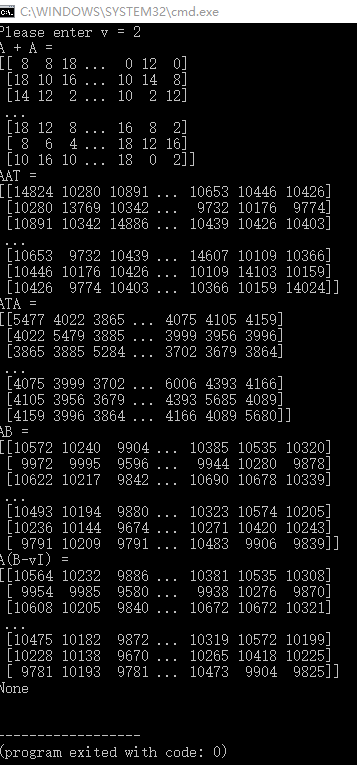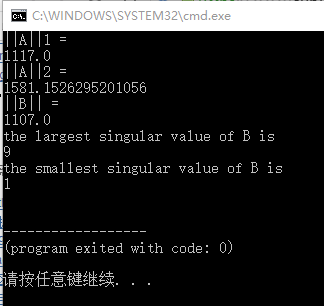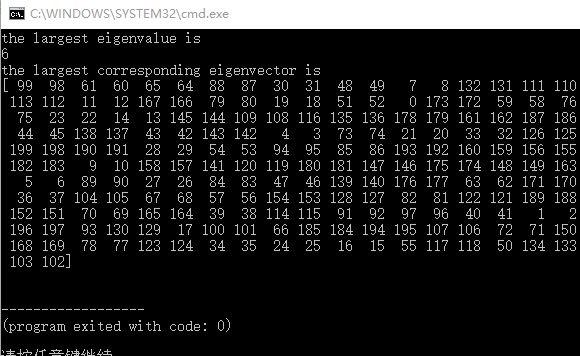exercises
Numpy
exercises 9.1
题目:
源代码:
from numpy import *
import numpy as np
def fun(A, B, v, I):
print("A + A = ")
C = A + A
print(C)
print("AAT = ")
D = A * A.T
print(D)
print("ATA = ")
E = A.T * A
print(E)
print("AB = ")
F = A * B
print(F)
print("A(B-vI) = ")
J = I*v
B = B - J
A = A*B
print(A)
I = mat(eye(500, 200, dtype = int))
A = mat(random.randint(10, size = (200, 500)))
B = mat(random.randint(10, size = (500, 200)))
v = int(input("Please enter v = "))
print(fun(A, B, v, I))
完成结果:
exercises 9.2
题目:
源代码:
from numpy import *
import numpy as np
def fun(B, b):
print("x = ")
x = B/b
print(x)
B = mat(random.randint(1, 10, size = (500, 200)))
b = mat(random.randint(1, 10, size = (500, 1)))
fun(B, b)
完成结果:
exercise 9.3
题目:
源代码:
from numpy import *
import numpy as np
def fun(A, B):
print("||A||1 = ")
print(np.linalg.norm(A, ord=1))
print("||A||2 = ")
print(np.linalg.norm(A, ord=2))
print("||B|| = ")
print(np.linalg.norm(B, ord=np.inf))
print("the largest singular value of B is ")
print(B.max())
print("the smallest singular value of B is ")
print(B.min())
A = mat(random.randint(1, 10, size = (200, 500)))
B = mat(random.randint(1, 10, size = (500, 200)))
fun(A, B)
完成结果:
exercises 9.4
题目:
源代码:
from numpy import *
import numpy as np
def fun(Z, A, B):
print("the largest eigenvalue is ")
print(np.argsort(A)[0])
print("the largest corresponding eigenvector is ")
print(np.argsort(B)[0])
Z = np.random.random_integers(100, size = (200, 200))
A,B = np.linalg.eig(Z)
fun(Z, A, B)
完成结果:
exercises 9.5
题目:
源代码:
from numpy import *
import numpy as np
def fun(C, p):
for i in range(0, 200):
for j in range(0, 200):
if np.random.rand() < p:
C[i][j] = 1
print("the largest singular vale is ")
x = np.linalg.svd(C)
print(x[0])
C = np.zeros([200,200])
p = float(input("p = "))
fun(C, p)
完成结果:
exercise 9.6
题目:
源代码:
def fun(z, A, n):
le = abs(A[0]-z)
zz = A[0]
for i in range(0, n):
if abs(A[i]-z) < le:
le = abs(A[i]-z)
zz = A[i]
print(zz)
z = int(input("z = "))
n = int(input("n = "))
A = []
for i in range(0, n):
data = int(input())
A.append(data)
fun(z, A, n)
完成结果:











